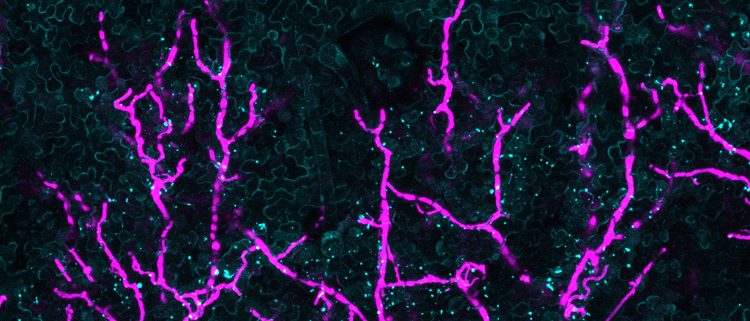Phytophthora infestans: The notorious plant destroyer is a master manipulator
FEATURED FIGURE CAPTION: Live imaging of Phytophthora infestans (magenta) growing on Nicotiana benthamiana cells (cyan). Cells that are colonized by the pathogen show increased numbers of vesicles (bright cyan dots) compared to cells that haven’t been colonized yet.
By Mauricio P. Contreras, The Sainsbury Laboratory, University of East Anglia, Norwich Research Park, Norwich, United Kingdom
Background: Much like us, plants get sick too. Disease-causing microbes, termed pathogens, can infect plants and severely impact crop yields, posing a major threat to global food security. A famous example of one such pathogen is Phytophthora infestans, the fungus-like oomycete organism that triggered the devastating Irish potato famine in the mid 19th century. During infection, these pathogens deliver specialized molecules, called effector proteins, into plant cells. Effector proteins can interact with plant proteins inside the cell in order to alter their functions. In this way they manipulate a variety of plant processes and promote disease.
Question: We still do not fully understand which plant proteins and processes are manipulated by pathogen effectors. To answer this question, we used a large collection of Phytophthora infestans effectors as baits to map out which plant processes are targeted during infection in the model plant Nicotiana benthamiana.
Findings: We found that P. infestans effectors can associate with a broad range of plant proteins in N. benthamiana. The fact that they interact with plant proteins involved in so many different processes suggests that this pathogen can massively reprogram the way plant cells work in order to promote growth on the host. In particular, we noticed that a large number of effectors seemed to target the machinery that the plant uses to move cargo around inside of the cell. Cells can move their contents around in small compartments we call vesicles. By using advanced microscopes, we were able to observe living plant cells and actually see how effectors alter these vesicles’ behavior and abundance. We think that by changing the way in which the plant cell transports its contents, P. infestans might be able to infect its host plant more readily and cause severe disease.
Next steps: Our work has identified several plant processes that are targeted by Phytophthora infestans during infection. We hope that this knowledge will inspire other scientists to explore in more depth how these different plant processes are being manipulated. By understanding how microbes cause disease in plants we can develop new strategies for breeding more resilient crops.
Benjamin Petre, Mauricio P Contreras, Tolga O Bozkurt, Martin H Schattat, Jan Sklenar, Sebastian Schornack, Ahmed Abd-El-Haliem, Roger Castells-Graells, Rosa Lozano-Duran, Yasin F Dagdas, Frank L H Menke, Alexandra M E Jones, Jack H Vossen, Silke Robatzek, Sophien Kamoun, Joe Win (2021) Host-interactor screens of Phytophthora infestans RXLR proteins reveal vesicle trafficking as a major effector-targeted process. Plant Cell. https://doi.org/10.1093/plcell/koab069




